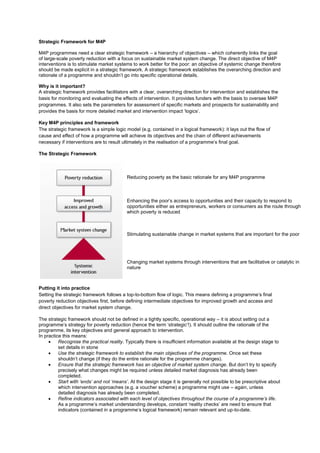
Strategic Framework Handout
- 1. Strategic Framework for M4P M4P programmes need a clear strategic framework – a hierarchy of objectives – which coherently links the goal of large-scale poverty reduction with a focus on sustainable market system change. The direct objective of M4P interventions is to stimulate market systems to work better for the poor: an objective of systemic change therefore should be made explicit in a strategic framework. A strategic framework establishes the overarching direction and rationale of a programme and shouldn’t go into specific operational details. Why is it important? A strategic framework provides facilitators with a clear, overarching direction for intervention and establishes the basis for monitoring and evaluating the effects of intervention. It provides funders with the basis to oversee M4P programmes. It also sets the parameters for assessment of specific markets and prospects for sustainability and provides the basis for more detailed market and intervention impact ‘logics’. Key M4P principles and framework The strategic framework is a simple logic model (e.g. contained in a logical framework): it lays out the flow of cause and effect of how a programme will achieve its objectives and the chain of different achievements necessary if interventions are to result ultimately in the realisation of a programme’s final goal. The Strategic Framework Reducing poverty as the basic rationale for any M4P programme Enhancing the poor’s access to opportunities and their capacity to respond to opportunities either as entrepreneurs, workers or consumers as the route through which poverty is reduced Stimulating sustainable change in market systems that are important for the poor Changing market systems through interventions that are facilitative or catalytic in nature Putting it into practice Setting the strategic framework follows a top-to-bottom flow of logic. This means defining a programme’s final poverty reduction objectives first, before defining intermediate objectives for improved growth and access and direct objectives for market system change. The strategic framework should not be defined in a tightly specific, operational way – it is about setting out a programme’s strategy for poverty reduction (hence the term ‘strategic’!). It should outline the rationale of the programme, its key objectives and general approach to intervention. In practice this means: Recognise the practical reality. Typically there is insufficient information available at the design stage to set details in stone Use the strategic framework to establish the main objectives of the programme. Once set these shouldn’t change (if they do the entire rationale for the programme changes). Ensure that the strategic framework has an objective of market system change. But don’t try to specify precisely what changes might be required unless detailed market diagnosis has already been completed. Start with ‘ends’ and not ‘means’. At the design stage it is generally not possible to be prescriptive about which intervention approaches (e.g. a voucher scheme) a programme might use – again, unless detailed diagnosis has already been completed. Refine indicators associated with each level of objectives throughout the course of a programme’s life. As a programme’s market understanding develops, constant ‘reality checks’ are need to ensure that indicators (contained in a programme’s logical framework) remain relevant and up-to-date.
